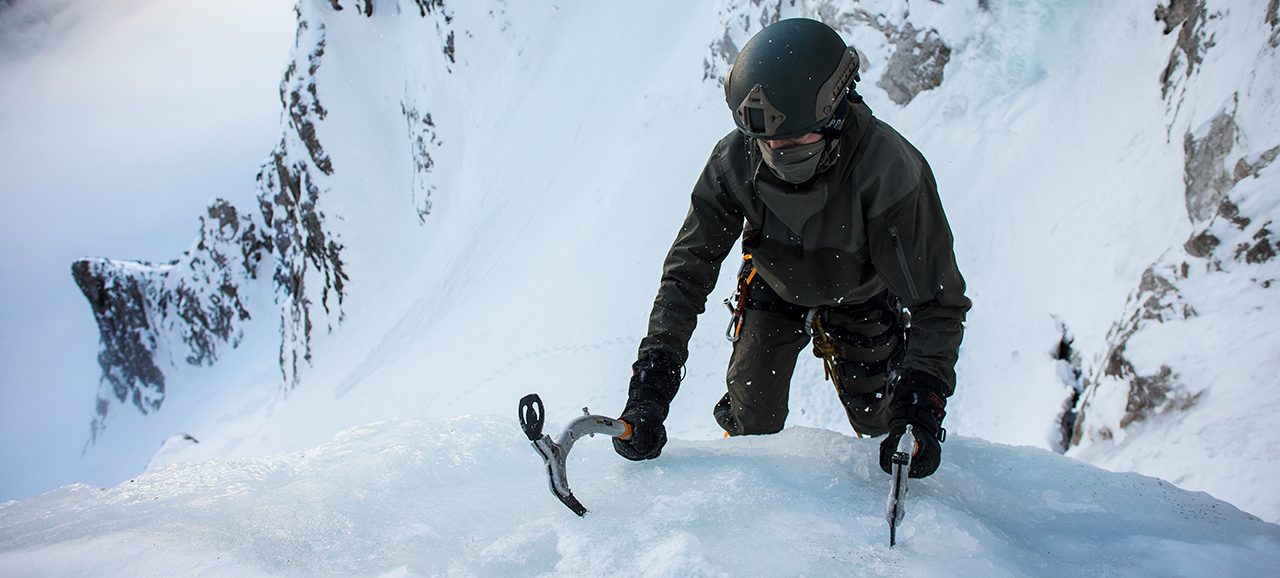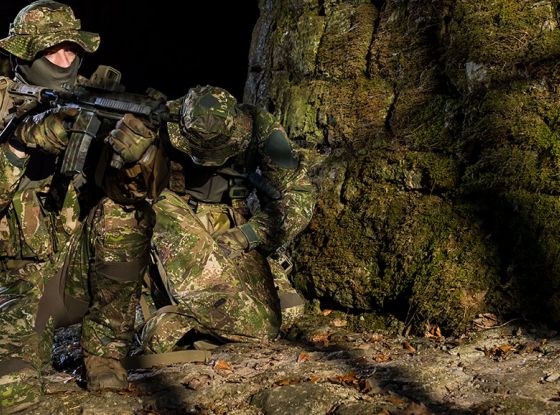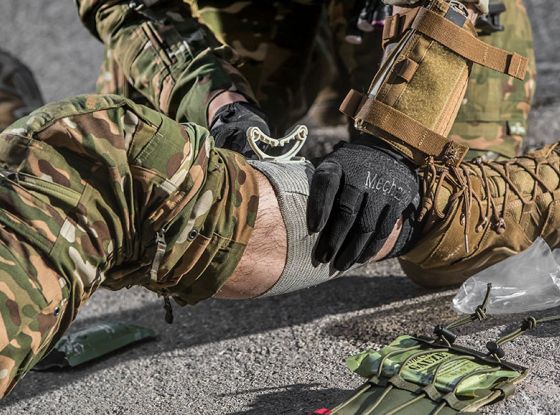Finding the optimal thermal insulation material that works in any condition and has the exact properties we are looking for is quite the challenge. Various factors, like your activity level and moisture play a crucial role in the selection process. But how do we find the perfect insulator? What key parameters must be taken into account?
Contained in this blog post:
Introduction
As with other key elements of your clothing, there are many viable options when it comes to choosing the right material for tactical winter gear.
The same is true of thermal insulation, which offers two distinct options and one in-between variant. The first option:
Natural thermal insulation materials
- Fur
- Goose Down
- Merino Wool
These are well-known and thoroughly researched.
They provide excellent—if not best-in-class—features and thermal properties, exactly those that we strive to achieve in all man-made materials.
They therefore serve as a baseline for what we seek in a desirable thermal insulation material.
Seems like this is an easy choice, one that brings to an end our search for an alternative solution where our primary focus is a high quality-to-features ratio.
Alas, no, it does not.
As the tactical branch is a very specific field entailing specific gear uses, we need to realize that not every material is the correct choice, even if it is top-notch quality.
Naturally, we can look beyond the scope of nature and take a look at synthetic solutions available to us. First, we have:
Synthetic thermal insulation materials:
- Microfleece
- Synthetic Filler (examples include G-Loft, Polartec, and Climashield)
Man-made insulation was developed as an attempt to resolve certain issues encountered with and not easily solvable by natural types of insulation.
Weight is one of the two most significant of those issues, the second being susceptibility to water (that is, the hydrophilic properties of a material) which can easily disrupt a garment’s effectiveness in cold weather.
Both of these are a key point when trying to build the optimal piece of tactical clothing.
The last category in materials we are discussing is the mix of the two previously mentioned.
Synthetic/natural
An example for the latter is the incorporation of camel hair in a cluster-structured material.
We can take a look at an example on G-Loft. Its base bicomponent fiber would in this case be replaced with camel hair, keeping the clustering intact.
We are currently looking into this field—particularly for the reason that we find it a very interesting one.
But we also recognize that it is not quite developed enough for us to aggressively pursue.
SIGN UP FOR MORE INTEL LIKE THIS.
Enter your email and stay in the know with future topics about cold weather gear.
You are signing up to receive updates via e-mail from which you can opt out at any time. Visit our privacy policy for more info.
How does thermal insulation work?
Thermal insulation refers to the inhibition of thermal energy transfer from one place to another on a piece of material. Thus, if a material has thermal insulation properties, it will be able to slow the transfer of large amounts of heat.
Clothing works on basic principles of heat transfer, or heat flow, if you prefer. Your body radiates heat at a normal temperature of 36.5 to 37.5℃.
On a cold winter day, the difference in temperature between the chilled air and your warm body is large enough to pose a real threat—unless there is thermal insulation between you and that icy air.
Without a layer of clothing over your body, cold outside air comes into direct contact with your skin and lowers it’s temperature to a point at which you would freeze (if there’s a breeze, that wind chills your body even faster).
So, if, for example, you are in a sub-zero environment and put on a winter jacket, the goal of that garment will be to trap enough heat from your body and allow it to transfer at a slow enough rate to keep you from freezing.
Here is how wearing that jacket will slow the heat-loss process:
- The jacket (especially if it has a thermal insulation filing) traps your body heat and prevents its rapid transfer to the surrounding cold air.
- The jacket acts as a layer between the external cold and your body’s radiated warmth, and—because of the air trapped inside—slows the transfer of heat.
Heat is just another word for energy flow.
It normally flows from high to low—from your warm body (the high point) to the cold air enveloping it (the low point).
We can disrupt that flow and, in the process, stay warm, by using a layer that has heat-transfer inhibition capability.
But what qualifies as a good insulator?
Basically, the less dense the material used for insulation, the better the insulating characteristics. One of the least dense material you can probably think of is air.
But it doesn’t seem like air should count as an insulating material because we can freely walk through it.
Well, air is a gas—and the fact is gases have extremely good thermal inhibition properties thanks to their structure.
Dense materials are made up of atoms closely spaced. The closer the spacing, the denser the material. However, the wider the spacing, the less effective the transfer of energy is from one atom to the next.
This is why air excels as a thermal insulator. It is made up of widely spaced atoms.
Therefore, if contained within a system of connected small packets, air can provide an optimum amount of lasting insulation in every direction.
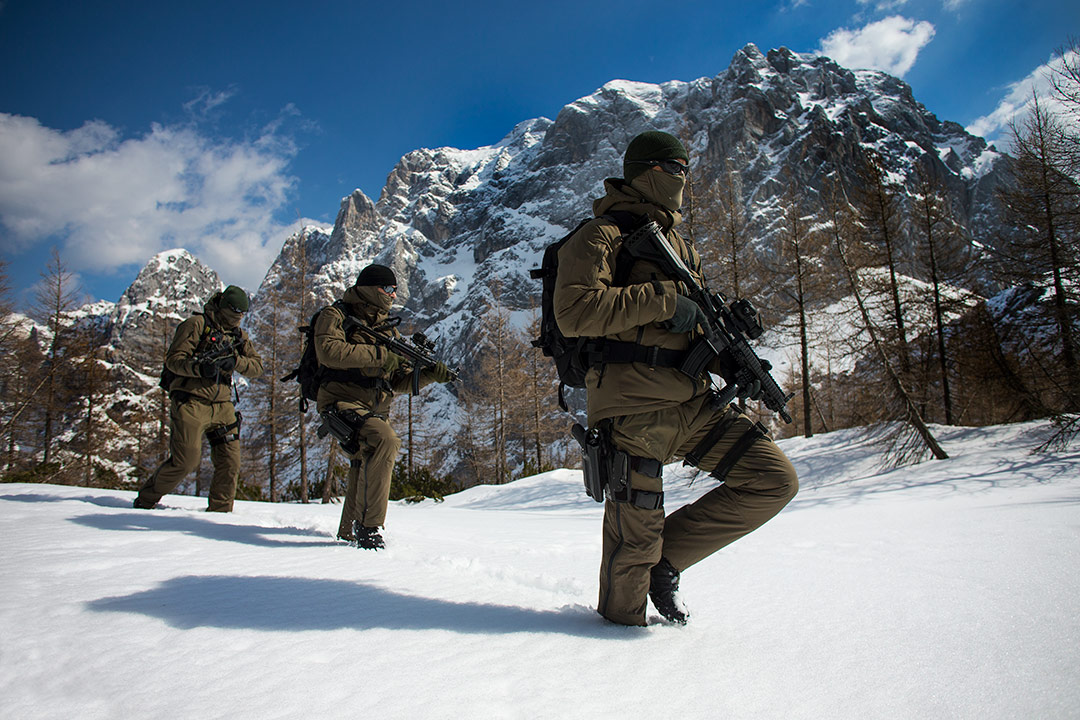
What do we look for in thermal insulation materials?
Before cold-weather clothing can be constructed it must be designed. Before it can be designed there must be a guiding idea behind it.
So we always begin our cold-weather gear development by recognizing that the material will need to perform at a high level in each of these categories in order to be deemed a suitable choice:
- Thermal insulation
- Durability/Care
- Compressibility
- Breathability
- Susceptibility to water
Let’s take a closer look at each of these categories to understand its importance.
In doing this, we’ll compare natural goose-down (a traditionally high-tier performance-goal standard) to synthetic non-woven materials (G-Loft, to be precise).
We’ll leave fur out of the comparison because it’s such a heavy material (even though it provides some of the best thermal insulation, even when wet).
Besides, we disfavour use fur in tactical garments for that very reason—the hefty weight.
The extra gear that operators so often carry adds significant weight as it is; the last thing they need is for their tactical garments to also weigh a lot from the inside out.
And we’ll also overlook comparing microfleece against merino wool.
Both are great choices for adding protective layers against cold weather, thanks to their functionality alone.
But in this discussion we want to look at just the material that serves as the primary insulator against sub-zero temperatures.
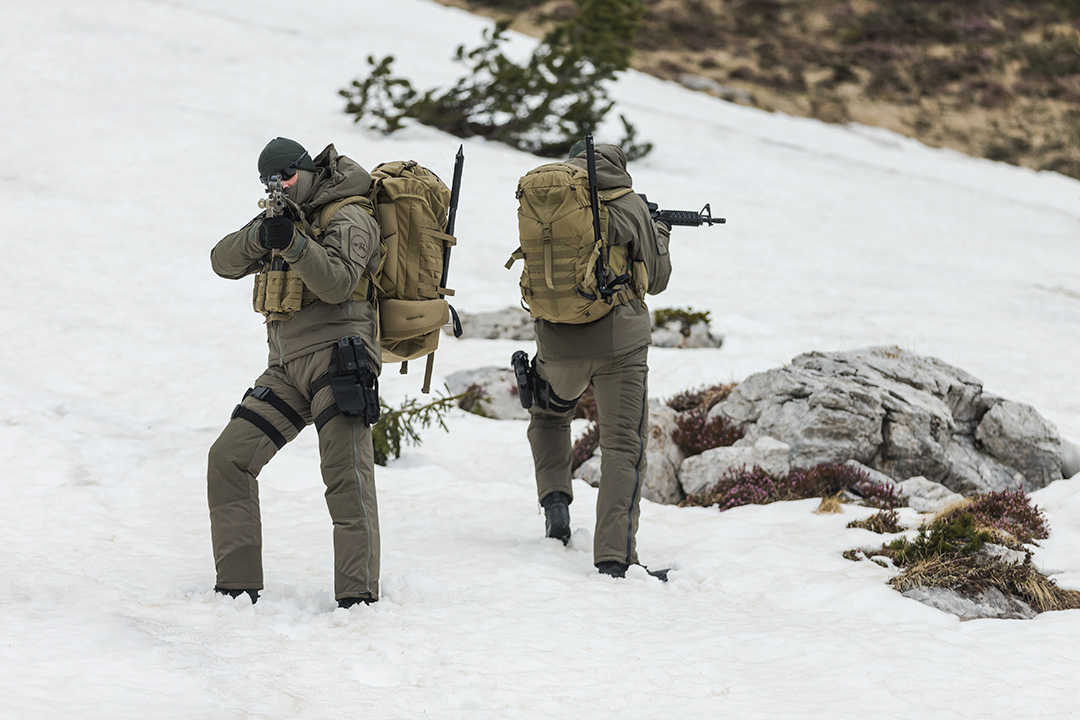
Thermal insulation properties
This category presents us with the simplest choice. All that we need to do is test the materials based on their performance in cold temperatures.
In this regard, goose and duck down offer exceptional thermal insulation that outperforms synthetic fibres.
Specifically, we are looking for materials that have high thermal-insulation properties per weight index.
Fill power is a measure of the loft or "fluffiness" of down and is loosely correlated to the down’s insulating value.
The higher the fill power, the more air of a certain weight the down can trap; thus, the more insulating capacity the down will have.
Winner: Goose down. It has one of the highest indexes in this category, outperforming non-woven synthetics.
Durability/Care
Next, we consider how thermal insulation fares when exposed to the teeth of time and usage. We also consider what it’s going to take to keep your gear in top-notch condition.
It used to be that goose down was suitable for dry cleaning only (which can be a real pain, especially if you are out on a mission or if repeated washing has rendered it less effective).
But we’ve recently come across newer incarnations of goose down-filled gear that can be successfully washed at low temperatures.
Not taking proper care of this type of jacket results in clumping and flattening over time. This, in turn, leads to significantly reduced functionality.
The non-woven synthetic group has the edge here. It offers easier care when washing and does not develop clumps, meaning it retains its functionality.
Winner: non-woven synthetics.
Compressibility
Packing up a mission-critical jacket is a must when it comes to tactical garments.
You need to be able to take it out of your backpack and get instant protection from cold weather, without first having to wave it around and perform a ceremonial evocation in order to puff it up with enough air to restore its shape and functionality.
While goose down has great compressibility, it does in fact take some time to puff up after retrieval from a backpack.
Another problem is goose down clumps up after repeated compressions, a problem you almost surely will encounter if you own the garment long enough.
Synthetic non-woven materials like G-Loft on the other hand have as a base for its clusters a fiber.
This means those clusters spring back from compression immediately, because of the properties of this fiber, immediately after you pull the garment from your pack, enabling it to be ready for use whenever you need it.
Winner: non-woven synthetics.
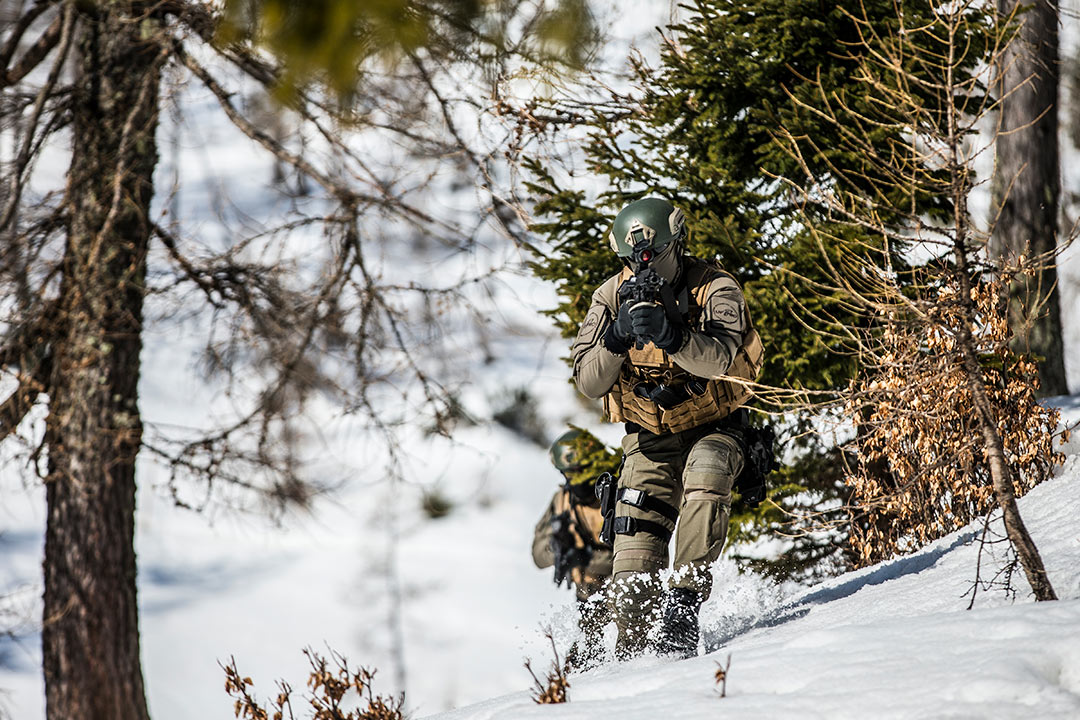
Breathability
Physical exertion in cold environments can cause you to sweat. Accordingly, the need to provide adequate breathability to dissipate the moisture becomes essential.
Both goose down and non-woven synthetics boast exceptional breathability, making them both a viable choice in this category.
Winner: draw.
Susceptibility to water
Materials prone to taking on water tend to have lower insulation properties when wet.
Water has two keypoint aspects we need to understand before declaring a winner of this category.
- First and foremost, some thermal insulators decrease drastically in volume when they absorb water. This results in a lower volume of air in the filling. In turn, this decreases its associated thermal insulation properties.
- Second, the water trapped in the filling saturates the air around it and limits the transport of moisture from your body to the outside.
Goose down tends to absorb water. When it becomes water-saturated, its effectiveness all but vanishes. You may have encountered this phenomenon with down-based gear you might already own.
Another drawback to goose down is it takes a long time to dry.
To overcome this problem, modern solutions infuse the down with a water-repellant agent. Doing so makes down usable under wet conditions.
However, this solution also raises another issue: the question of longevity and care.
Unlike down, synthetic fibres do not absorb moisture.
Consequently, they guarantee a very high thermal output, even in wet conditions. And when the fibres themselves get wet, they can be counted on to dry extremely fast.
Winner: non-woven synthetics.
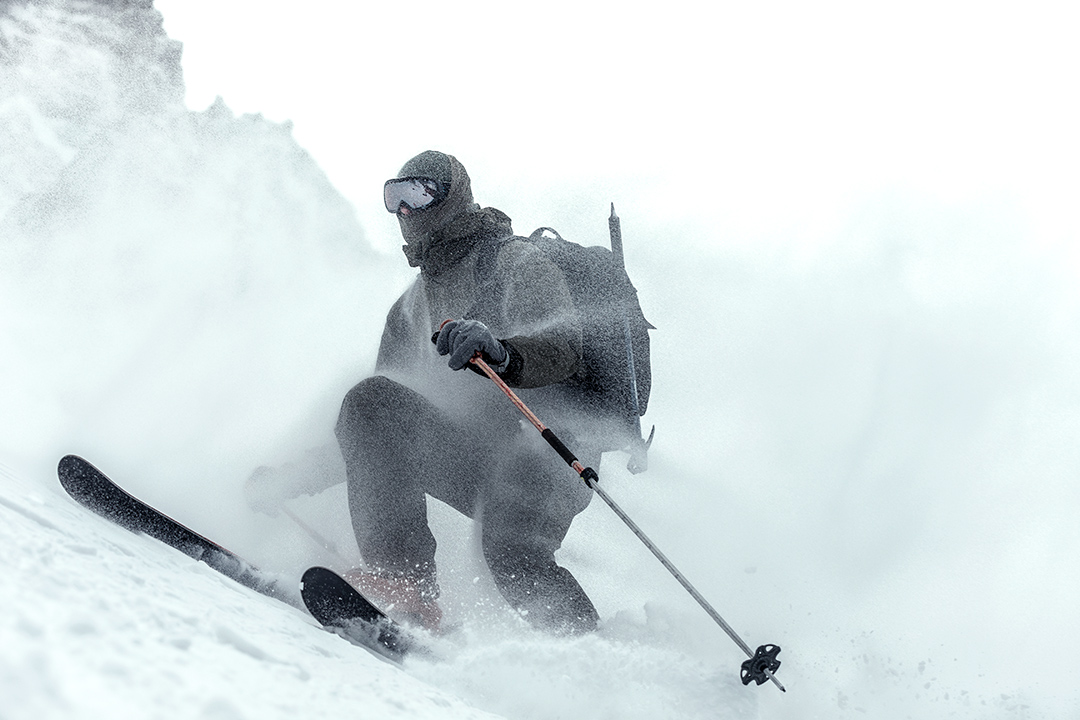
Down vs. G-Loft
When it comes to thermal insulation, down is still the king of the hill. Its high thermal performance per weight is hardly matched by synthetics.
As with many other natural materials, down’s thermal insulation properties have evolved over time, with the help of science.
Today, down is one of the best options available to us.
Down is however expensive to produce—for example, to obtain the highest quality down filling, one must begin with the best feathers and carefully hand-select from among them. Not that this is any factor for us, but it is notable.
Contrast this to G-Loft and other materials like it.
They check the box in almost every category we consider. Non-woven synthetics are reliable, easy to maintain, and durable.
In our tests for thermal insulative properties, non-woven synthetics finish standing on both feet.
But how—at the end of the day—do you measure this in a quantitative way?
Well for scientific purposes, there is a convenient test called a “skin model” and we use it to determine certain parameters.
This method is used to determine the Rct and Ret values of our candidate materials. Specifically, we examine:
- Rct (thermal resistance). This value depends on the candidate material’s thermal conductivity and thickness.
- Ret (water vapour resistance). This value measures the material’s ability to block the pass-through of water vapour.
However, such a test can reveal only part of the story, and you need the whole of it.
The other way to test is by putting the material through its paces out in the field.
Our gear undergoes extensive field testing—in real-life situations encountered by actual operators—before we finalize the design.
This is the main reason we choose G-Loft, it’s exceptional features and fitting right into what we are looking for in this type of a scenario.
It remains the choice we stand behind.
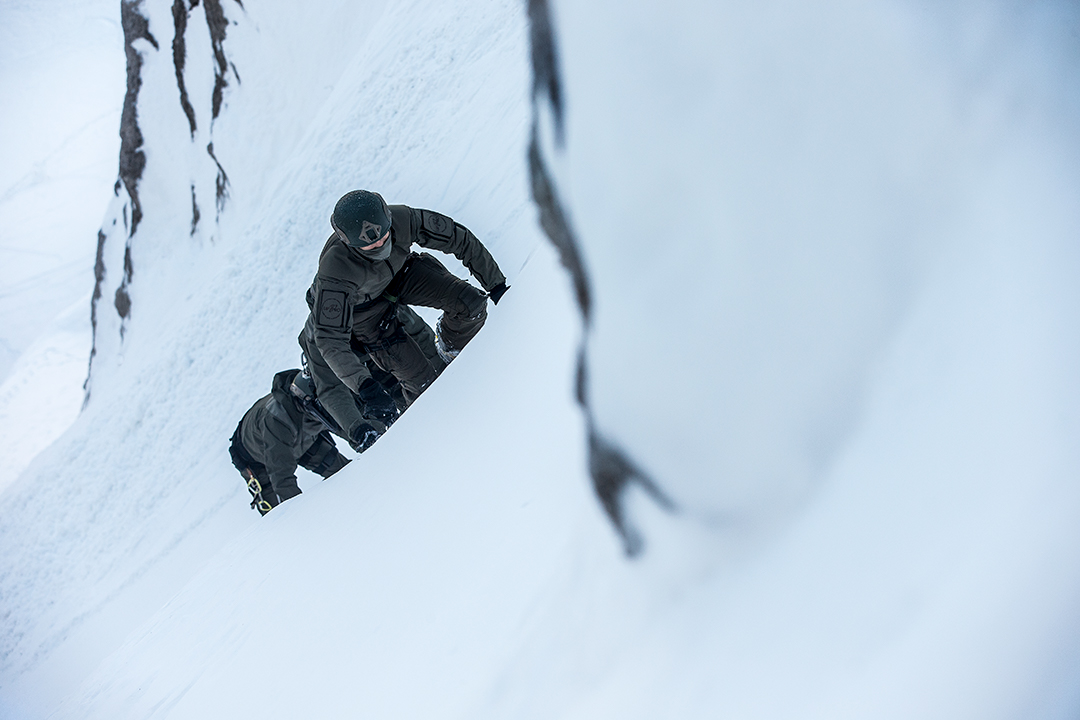
How does all that come together in our gear?
As you can tell, there are many considerations to be made when designing the perfect extreme cold weather gear for tactical use.
From all this we understand that there is no “one to rule them all” material for a high-performance jacket.
That is an insight we keep uppermost in mind when innovating ideas for a new garment.
But why? Well, first of all, there are variables to be weighed.
For example, is the garment intended for wear by someone who is highly physically active? If the answer is yes, then we need to design for what comes that, namely sweat and high bodily thermal output.
Our AcE Gen.2 Winter Combat Shirt and Delta AcE Plus Gen.3 Tactical Winter Jacket are examples of garments designed for highly physically active wearers (read, for wearers who will sweat and give off much heat).
Watch this spotlight video to learn everything there is to know about the AcE Gen.2 Winter Combat Shirt:
Notably, those garments feature G-Loft filling in the sleeves, but not in the vicinity of the chest and back.
The reason is that those upper torso areas are normally where the greatest buildup of heat occurs. This is particularly true when covering the wearer’s chest and back are a plate carrier and other sizable pieces of equipment—which, interestingly enough, act as additional layers of insulation.
Also, our AcE Gen.2 Winter Combat Shirt and Delta AcE Plus Gen.3 Tactical Winter Jacket include ventilation panels on each sleeve to provide additional cooling.
You would be correct to suspect that these garments are not waterproof.
They are instead highly water-repellent. The difference is that waterproof laminates are less breathable, heavier and have certain construction restrictions.
Usually when it is cold, rain becomes snow. Snow has drastically different properties than rain and when you inspect the surface of the garments you see that the snow melts on the surface then drizzles down the fabric.
Furthermore a waterproof laminate is heavier, less breathable and comes with additional constructional constraints - like no ventilation panels on the gear.
Also notable is that, operators usually carry with them waterproof outerwear in the event they encounter extremely wet conditions.
Microfleece lining is another material crucial to the effectiveness of our jackets.
The microfleece we use is COCONA 37.5. It’s our top choice because its features are ideal for our gear. Specifically:
- It swiftly transports moisture from your body to the outside and does double-duty by creating a larger surface area from which water can dissipate;
- It provides an additional layer for the garment’s thermal-insulation ecosystem;
- It feels good against your skin (in large part because the fabric doesn’t quickly become wet).
Additional elements for the jacket and combat shirt—such as our air/pac inserts—also factor into the thermal insulation scheme we are illustrating here.
Get more intel about the Delta AcE Plus Gen.3 Jacket in this product spotlight video:
These inserts are positioned along the back and shoulders to prevent carried gear from pressing the garment material directly down onto your skin.
This buffer allows air to make the contributions that help you stay warm in cold weather, by creating a “thermal bridge” effect.
All of these elements combined make our tactical clothing the best-in-class for anyone who operates in wintry climes.
We sincerely hope this discussion has given you an insight to the thermal insulation space and what it takes to create the top-notch, high-performance gear you’ve come to expect from us.
And as a bonus, we’d like to offer an answer to the most pressing of all questions: “For what temperature range is this jacket ideally suited?”
It depends. Really, it does. Having slogged your way to the end of this long article, you deserve to not be left hanging, so we’ll tell you upon what:
- Your activity level. The higher it is, the more heat you produce; thus, the lower you can go with a jacket.
- Layers worn underneath. Quality matters a great deal. Therefore, as a base layer, a Merino shirt is your best friend.
- Your susceptibility to cold. Our recommendation here is you man up.

